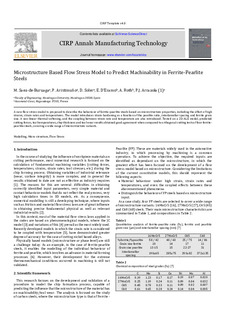
Izenburua
Microstructure based flow stress model to predict machinability in ferrite–pearlite steelsBeste instituzio
Ascometal (France)Bertsioa
Postprinta
Eskubideak
© 2019 Published by Elsevier Ltd on behalf of CIRPSarbidea
Sarbide bahituaArgitaratzailearen bertsioa
https://doi.org/10.1016/j.cirp.2019.03.013Non argitaratua
CIRP Annals Vol. 68. Nº 1. Pp. 49-52, 2019Lehenengo orria
49Azken orria
52Argitaratzailea
Elsevier Ltd.Gako-hitzak
ModellingMicro structure
Flow stress
Laburpena
A new flow stress model is proposed to describe the behaviour of ferrite–pearlite steels based on microstructure properties, including the effect of high strains, strain rates and temperatures. The mo ... [+]
A new flow stress model is proposed to describe the behaviour of ferrite–pearlite steels based on microstructure properties, including the effect of high strains, strain rates and temperatures. The model introduces strain hardening as a function of the pearlite ratio, interlamellar spacing and ferrite grain size. A non-linear thermal softening, and the coupling between strain rate and temperature are also introduced. Tested on a 2D ALE model, predicted cutting forces, tool temperatures, chip thickness and tool wear results obtained good agreement when compared to orthogonal cutting tests of four ferrite–pearlite steels, covering a wide range of microstructure variants. [-]





















